
“Dulcia Domestica” translates from Latin into “a home-made sweet” and what’s better than a home-made sweet when spring is here – according to the calendar – but is sitting in its room saying it won’t come out until it’s good and ready.
This spring is like a toddler, I swear.
Anyway, this is a Roman sweet from Apicius that I’ve made many many times, and brought it to the last meetup of the Boston Bitchery, and they LOVED it. It’s very simple, has four ingredients, and is just a little bit cheeky.
In Latin: palmulas uel dactilos excepto semine, nuce uel nucleis uel piper tritum inferies. Sales foris continggis, frigis in melle cocto, et inferes.
In English (Translation by Sally Grainger): Take the stone from palm dates or ordinary dates and stuff them with nuts or pine nuts or ground pepper. Roll in salt, fry them in cooked honey, and serve.
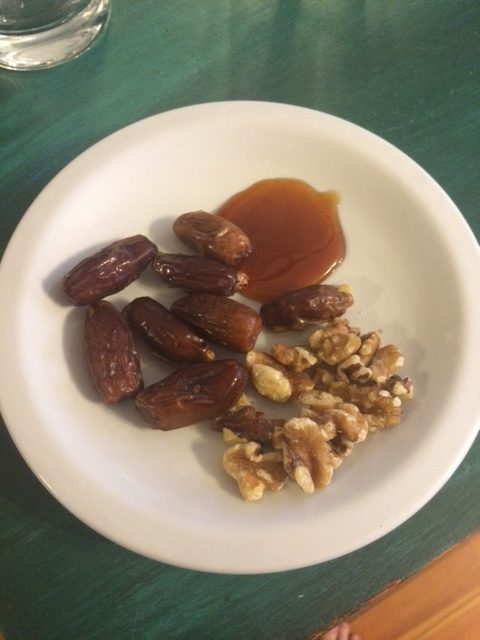
What’s cute is that this is a super simple illusion food: you can’t eat the pit of a date, but you can put something edible that simulates the pit and pop the whole thing in your mouth.
And I’m not kidding that it’s super simple! You can get pre-pitted dates, but the same number of dates with pits are about $3 cheaper. I usually use almonds, because the shape tends to make the stuffing part much easier. In this case I used walnuts (they were on sale). The Romans had both, and “nuce” means simply “nut” so feel free to have fun with it.
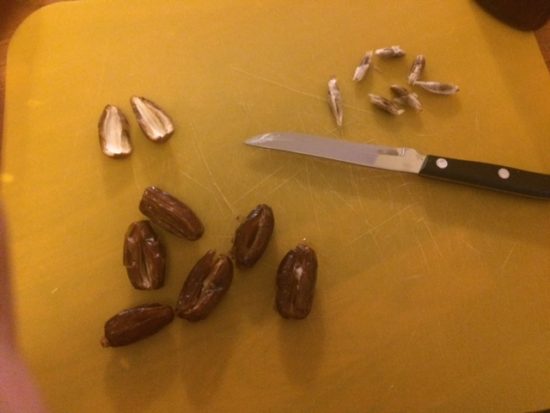
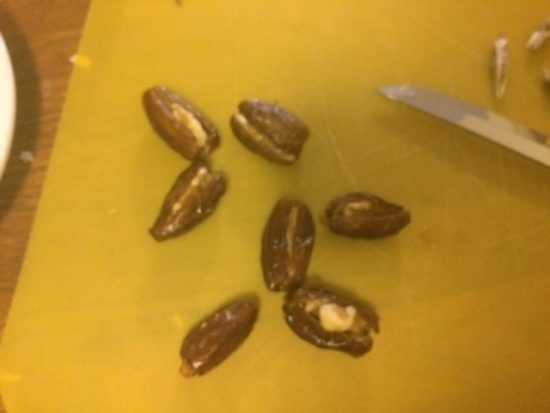
I have used ground pepper, which is fun, because putting ground pepper into dates is like priming tiny tiny grenades. It’s hard to get a good picture of that when there isn’t anyone around to help. I CANNOT ART UNDER THESE CONDITIONS.
My honey is from my uncle’s honeybees. He gives us a bottle of honey every year at Christmas. By local honey, y’all! It’s good for the bees, and good for your local ecosystem. If local honey isn’t easy to come by, make sure that the honey you get at the grocery store is 100% honey, and not part high fructose corn syrup. I am constantly trying to limit the amount of HFCS I eat, but it’s really hard – that stuff is in everything.
Heat up the honey until it starts to boil a bit, and throw the dates in and stir it around until they’re done. How do you tell? You kinda guess, less than five minutes, usually.

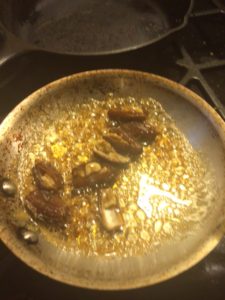
Some interpretations say, “We omitted the salt” and the implication is, “that seemed weird, so we didn’t do it.”
The salt brightens the dish and allows the flavors the bloom and meld. (Unless you use too much, then it’s just like a mouth full of salt.) So don’t omit the salt the first time because it seems weird. You might like what it does.
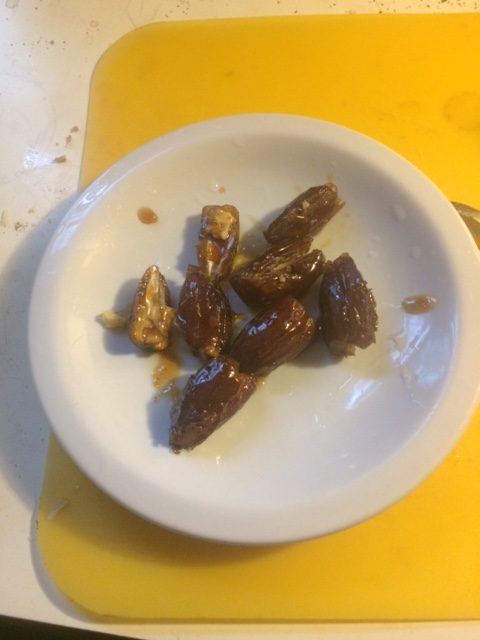
So I have made this for a handful of people, and I’ve made this for 180. (Well, I say “I” but I had help while I directed. Pitting 300 dates isn’t fun, but my friend Donovan did it in less than 2 hours, and didn’t even complain that much!) The Boston Bitchery loved them and were sad I didn’t make more.
It’s sweet with texture and tastes SO good if you use good quality honey. Enjoy!

I’m not really that into historical cooking – I only looked at this because I’ll read almost anything RHG writes – but this is so neat, and I’m going to have to try it.
This sounds delicious and easy; it reminds me of a Lynn Rossetto Kaspar idea — cut ripe figs in half, dip or brush the cut side with olive oil and sprinkle with black pepper. Grill cut side down, eat with chilled cream.
Query — what kind of pepper would the Romans have had. Was it black pepper or capsicum peppers?
This sounds delicious. Must try it.
@HeatherT – the Romans only had black pepper; capsicum peppers are New World plants.
And RHG – are you making these for this coming Tuesday’s meetup? Because if you are I’m even more excited to be going. So excited I might actually be vibrating when I get there.
Now I’m kinda sorry I moved back to Brooklyn – these look amazing! So fun to read about I might actually make…who am I kidding? I’m way more likely to just read about them again.
My gardeners club that is like a book club meets next week. We share simple treats and I may have found mine for this month. Those dates look delicious!
Oooooh. I do a thing where you replace the date pit with marzipan, it was one of thoe ‘jobs to keep little fingers occupied’ my mum gave me around Christmas, but you obviously don’t get a crunch. Will try.
My Latin teacher in high school once made us these for Christmas. She didn’t use any salt but they were so good!
That sweet still exists in South France, by the way. It’s popular around Christmas. I’ve heard it used to be known as ‘poor man’s nougat’, but today it’s just known as a nice comforting Christmassy thing!